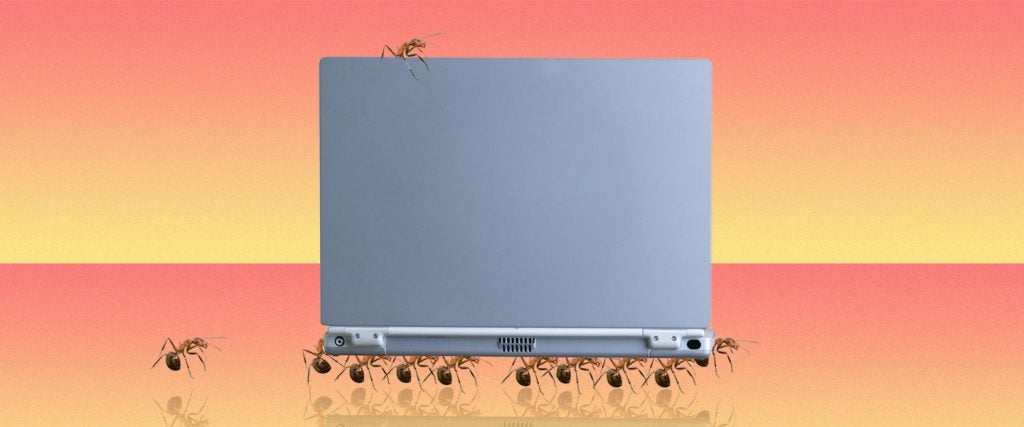When Dominic, a 21-year-old college student in Texas, returned to campus after a weekend at home, he noticed his computer sounded a bit different. Expecting that it had gotten gunked up with dust, he “took a look under the hood,” as he’d done many times before.
“My initial reaction was, ‘I don’t even know what I’m looking at,’” Dominic recalls. “But then I realized it was a swarm of ants, just little red ants, crawling in and out every crevice and wire in my computer like they’d been there for years.” After a quick Google search, Dominic had his diagnosis. “Crazy ants,” he says. “Not just regular ants, but crazy ants that apparently love to nest in people’s computers.”
Officially, they’re known as Nylanderia fulva. But unofficially, they go by “Rasberry crazy ants,” named after the Texas terminator — Tom Rasberry — who first discovered them in 2002. Over the next few months, Texan entomologists were horrified to discover the South American invasive ants were spreading at an unprecedented rate, with 11 different counties reporting infestations. And by all accounts, Rasberry crazy ants appeared to be genetically engineered by the bug gods to wreak havoc on our tech-dependent society.
The minuscule devils have a long history of chewing through wiring, causing electronics to overheat and computers to malfunction. Stories from the Texas infestations sounded like they’d been ripped from cheesy sci-fi movies. “Billions of electronic eating ‘crazy Rasberry ants’ invade Texas,” reads a 2008 article from The Times of London. “Having ruined pumps at a sewage facility, the ants are now marching towards Nasa’s Johnson Space Center and William P. Hobby Airport, Houston, putting state officials in a panic.”
Houston avoided disaster, but today, the Rasberry crazy ants have established colonies in all of the Gulf states and show no signs of slowing down, causing an estimated $156 million in electrical damage annually. Just ask Dominic, who two years later, is “very particular about keeping my computer elevated and away from any food and beverages.”
Such precautions are good, but they will only get him so far. The working theory is that Rasberry crazy ants may be attracted to the warmth or magnetic fields created by wires and electric currents. However, according to PJ Liesch, an entomologist at the University of Wisconsin’s Insect Diagnostic Lab, we haven’t quite figured out why they’d be attracted to electricity. “I have yet to see a good explanation for it in the scientific literature,” he tells me. “So it might simply be the case that they’re opportunistic nesters — plenty of ants nest inside electronic devices or appliances simply because there was an accessible protected spot.”
The real trouble, though, is with getting them out, as Rasberry crazy ants have proven impervious to most over-the-counter pesticides and aren’t tempted by traditional ant baits that have killed so many of their brethren. “The only thing that kills them is some chemical [fipronil] that the EPA made a special exemption for being legal in 2008, and only for counties that are facing infestations,” Dominic explains. “I thought maybe running a lot of programs might cook them out, but that didn’t work. For a minute, I really thought I may just put the thing outside and wave the white flag.”
Dillan Ovalle, an exterminator for Kilter Termite and Pest Control in Southern California, says he’s no stranger to the freakishly tenacious ants hell-bent on destroying computers. “These guys are extremely persistent,” he begins. For instance, if one dies from electricity, it releases pheromones that attract the colony to its defense. “That’s not good,” Ovalle explains. “You don’t want more; you want none — more ants will cause more damage.” Not only that, he continues, but “the colonies have multiple queens, which means they’re adept at rapidly reproducing, making it even harder to fully eliminate the entire group.”
That said, all hope is not lost. “The absolute best method for ants in a PC is to take apart the computer and bag up everything to suffocate any ants in the components,” Ovalle instructs.
“Suffocating them was my only option,” Dominic says. Even with finals week around the corner, he didn’t mess around, opting to disassemble his ant-filled computer into several airtight bags and set everything aside for almost three weeks. “It worked, thank god, and they died before doing much damage. So I was able to clean them out and get her going before the end of the semester.”
Ever the professional, Ovalle would have advised Dominic to call an exterminator. “If you live in a place that allows it, get a gel bait that contains fipronil — I recommend Maxforce Quantum,” he says. “Put some of that near their trail, and the ants will take as much bait as possible and return to the nest with it, which should quickly and effectively kill them all.”
That’s not all either. “They will come back if you’re not thorough, so after that, you should spray a coat of insecticide, creating a barrier around the perimeter of the house and wherever the trail or nest is located,” he recommends. “Using all three methods — the bagging, bait and spray — would definitely wipe out the colony within 48 hours.”
Dominic eventually moved “far, far away” from his likely-infested college apartment complex, but he’s still haunted by those dastardly Rasberry crazy ants. “Whenever my system fan makes an abnormal noise, I start looking for ants,” he laughs. “I reckon maybe I should just look for jobs up north and not worry about waking up to all my stuff being eaten by bugs again.”

